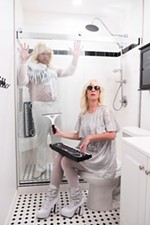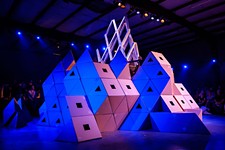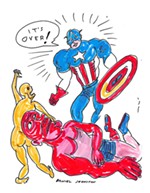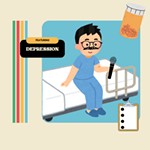Who Is Stella Burden, and Why Are They Saying Those Terrible Things About Her?
When the Rude Mechs create a show about acting, they find madness in the Method
By Robert Faires, Fri., March 28, 2008

They call her "the other Stella."
Meaning other than Stella Adler, the acting teacher whose approach to the craft – and specifically to that revolutionary technique known as the Method – is said to have had a profound impact on American acting in the 20th century. Stella Burden, alas, had no Brando or De Niro or Keitel among her pupils, but like her more renowned namesake, was an actress of little note who found her true calling training actors and attained guru status through a very specific philosophy and exercises. And some of those exercises were said to be dangerous, so dangerous that one of them – the so-called Method Gun – may have been responsible for her death.
If you've never heard of "the other Stella," don't sweat it. She was an obscure figure even during the decades she was teaching in this country; once she bolted for South America to found a training academy in the jungle, her history grew hazier still. In fact, so few facts about her survive that it's almost as if she never really existed. But the biographical minutiae of Stella Burden wasn't what drew the Rude Mechs to her; it was what she was – a mythic counterpart to the more stellar Stella, her soap-operatic evil twin, a dark, snarky doppelgänger like that goateed Spock in the mirror universe episode of Star Trek – and the way she courted death in the pursuit of her art. That's what led them to develop a show about her, and their pursuit of her and the principles of her "approach" has led this theatre collective – no stranger to long, strange trips – on one of its longest and strangest ever, taking them from blindfolded gunfire in Texas to Andean folk dancing in Ecuador to full-frontal male nudity in upstate New York.
The Trigger
It all started with a gun. Maybe.
Or maybe not. Maybe it was just a metaphor for a gun. Or the idea of one.
In any case, the name of the exercise created by Stella Burden included "gun," and with the rumors that it was connected to her death, the Rudes naturally assumed that the gun was indeed a real bullet-discharging gun.
So when Kirk Lynn, the Rudes' resident playwright and token male among its five co-producing artistic directors, circulated an e-mail to his fellow copads saying, "Hey, I have an idea for a play about this acting guru who creates an exercise by which she dies," with the exercise being called the Method Gun, visions of firearms began going off in their heads.
Visions of Chris Burden, who, in 1971, had a friend shoot him in the arm as a piece of performance art.
Visions of the magician Chung Ling Soo, who was accidentally shot in the chest while performing "the bullet catch" and died onstage.
Visions of Brandon Lee and Jon-Erik Hexum, actors who died from shots with prop guns.
And, of course, visions of Chekhov's dictum that if you put a gun onstage in the first act, you have to fire it by the third.
But how can you really shoot a gun onstage? "We've always been interested in Anne Bogart's notion of things you can't fake," says Lynn. "But that's one thing you must fake," notes copad Lana Lesley. And if the audience knows it's fake, does that take away from the truth of the moment? How would the Rudes be able to duplicate Stella Burden's point about truth in performance in their play with a fake?
It left the group wondering where to go next, a question they would decide, naturally enough, with a gun.
The Trajectory
The story goes that Stella Burden hailed from Texas, and when she decided to get the hell out of Texas, she put a map on the side of her daddy's barn and fired a gun at it, letting the bullet hole determine where she'd go. The Rudes decided to re-create this incident, with the idea of determining where they should go to do further research on Stella's life and work. With a map of the world tacked to some hay bales, each of the four local copads (Sarah Richardson copads long-distance from New York) took a turn putting on a blindfold, grabbing a .22 pistol, and taking a shot. (Video of the event is online at www.rudemechs.blogspot.com.)
Madge Darlington hit Papua New Guinea.
Shawn Sides also put a bullet in the South Pacific, in the Kiribati islands.
Kirk Lynn shot Iceland. At least that was the landmass nearest the bullet hole.
Lana Lesley shot Baghdad. "She literally shot the 'dad' out of Baghdad," says Darlington. "But we had a rule that we were not going to any contemporary war zones," adds Lynn, so she was allowed a do-over.

"Then I shot Ecuador," says Lesley, and with some five-figure grants from the Doris Duke Charitable Foundation's Multi-Arts Production Fund and the Creative Capital Foundation, that's where they went.
Providence seemed to be smiling on them (or perhaps working as a silent sixth copad) as this was near the South American compound where Burden allegedly spent her final years. They hoped to interview people who had met the elusive teacher, but the closest they got was the director of the Quito performing arts company Humanizarte who knew of her work. And he spoke mostly Spanish. (They're still translating his interview a year later.) One thing, however, that the Rudes did glean from Nelson Diaz: Living in a mestizo culture, Ecuadorans don't have the obsession with purity that European cultures do. People in different areas may practice different kinds of Andean folk dance, but no one tries to claim that they dance the one true Andean folk dance.
"You hear a lot of acting teachers say, 'This is the way to do it,'" admits Lynn. It's not a method; it's the Method. Even Stella Burden's version was the Approach. So what does that say about acting and truth and teachers of acting who say there's just one way to the truth?
The Ammunition
Truth or beauty?
Supposedly, that's the question – the only question – that Stella Burden posed to people who wanted to study with her. No preface to the query, no discussion of the words' meaning, no context. Just the three words loaded up and fired point blank. And the answer determined whether or not Burden took you in her class. From 1954 to 1974, she only accepted students who answered, "Truth." Then in 1975, she reversed herself and took students who said, "Beauty." A year later she was dead.
Kirk Lynn had encountered this question as a fellow in the Michener Center for Writers. The poet Marie Howe, who was a visiting professor, would begin her classes by asking each person, "Truth or beauty?" ("Obviously, she must have gotten that from Stella Burden," says Lana Lesley.) Having seen how provocative the question could be, the Rudes began asking the question themselves, to arts presenters at the Under the Radar Festival in New York, to 700 artists and arts presenters at a Creative Capital artists' retreat, to everyone. Interestingly, they say, the answers always seem to come out in a 50-50 split (except for the copads, "who are shockingly all 'truth,'" says Lynn).
In March of 2007, the project was opened to the full Rudes company. Anyone who had an idea to explore, no matter how tangential it felt to the project, could lead a night of lab work. Lynn led an evening based on Susan Sontag's essays about photography. Madge Darlington led an evening at the shooting range. Graham Reynolds led an evening in which everyone composed music. Thomas Graves led an evening about gurus, with company members taking turns teaching one another acting techniques in the style of gurus they knew.
This last lab led to a key concept in the project's development, the 80/20 principle. "There were times when the lab went off the road, and we didn't know exactly what has happening," Lynn explains. "Like one of our company members yelled at Thomas and ran out of the room and got in her car and took off. We were pretty sure that she was not really angry, that she was performing anger, but we weren't certain. I was pretty sure that everything that was happening was supposed to be happening, but 20% of me was worried."
That uncertainty, says Lesley, "was a really pleasurable feeling that we wanted to exploit."
The Shooting Range
After the 2½ months of lab work, the Rudes needed some place where they could pull together the most cogent ideas that had surfaced and begin developing them into a Method Gun play. They got it through the Orchard Project, a program that gives arts groups time and space to develop work on a 180-acre resort property in Maplecrest, N.Y. Fourteen company members took the trip and spent a week developing scenes.
"Getting out of town and getting to isolate ourselves was fantastic," says Lynn. "All you had to do morning, noon, and night was think about The Method Gun, read Tennessee Williams, and go run off into the woods and make scenes and come back together. I think because there were other artists there, there was a sense of both camaraderie and challenge. Our friends from Radiohole were there, and they were out running around filming each other naked in the woods at night, and we wanted to rise to the challenge of 'How would we do nudity?'"
Thus was born Snakes on a String, a bit in which Lynn and Graves appeared onstage in the altogether with helium balloons attached to the most serpentlike appendages on their anatomies. (Before they presented this segment at the Orchard Project, Graves said to Lynn, "There's nothing left to this but the humiliation.") At first blush, it might have seemed to bear no relation to Burden or the other elements circling around the nature of acting, but one wonders if Stella herself might have seen in those exposed men and their balloons some echo of that primal question: Truth or beauty?
The Test Shot
One account of Stella Burden's later years has her spending 13 months in rehearsal on A Streetcar Named Desire. By the time the Rudes open their workshop version of The Method Gun in December of 2007, they've been developing the play for at least that long, and there are still four months until the play's premiere at the Long Center for the Performing Arts. Though the workshop gets a bead on many of the ideas about Stella and acting and truth that the Rudes have been investigating for so long, they feel it hasn't hit the bull's-eye. In feedback sessions after the performances, questions were raised about the portrayal of Burden and her students. Audiences wondered why people would study with this woman. Were the Rudes making fun of her? Were they making fun of actors, of what it means to pursue a craft?
The intent of the project had not been to mock actors or the pursuit of craft. That would be the Rudes mocking themselves, mocking the work they've done and the collective to which they've devoted all their energies for a dozen years. They have a healthy sense of humor about themselves but wouldn't ridicule that. So they went back into the rehearsal room and reworked concepts, bringing more of themselves to the piece, blurring that line between the actors who worked with Stella Burden and the Rude Mechs, finding a space where you're pretty certain of the line between characters and actors, but 20% of you may be not sure.
The final version of The Method Gun includes text by Tennessee Williams, but instead of using The Night of the Iguana, as in the labs, or Cat on a Hot Tin Roof, as in the workshop, the Rudes focus on A Streetcar Named Desire, only the most familiar characters – Blanche, Stanley, and, oh yes, Stella – never appear. The actors portray only supporting characters, sometimes reciting dialogue to figures who aren't there. A strange way to stage Streetcar, perhaps, but fitting for a play inspired by a woman who's not there more than she's there.
"It's so hard to piece together what actually happened to Stella Burden," says Lynn.
"There were so many rumors," notes Darlington.
"We jumped to the conclusion that the Method Gun involved a gun because of the name of the exercise," says Sides.
"We were probably wrong," admits Lesley. "Now we've come full circle and think that's probably not what the exercise was." And what became of Stella Burden? Maybe instead of dying, she simply disappeared.
So who was "the other Stella"? It's hard to say. Maybe she's the greatest acting teacher no one ever knew, or maybe she's just the sound of Chekhov's gun not being fired.
The Method Gun runs April 2-12, Tuesday-Sunday, at the Rollins Studio Theatre in the Long Center for the Performing Arts, South First at Riverside. For more information, call 474-LONG or visit www.thelongcenter.org.










